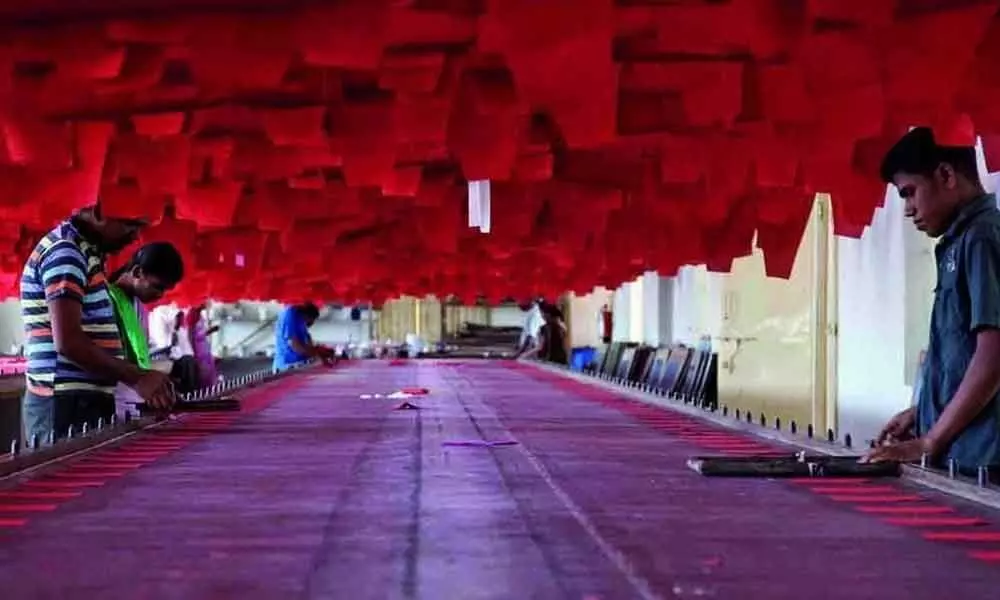The dark side of colourful textiles

The dark side of colourful textiles
These bright, colourful clothes have a dark side as their colours cause severe negative impacts on the surrounding environment
Textiles are not only the basic needs of a human being but have also become a fashion statement. But these bright, colourful clothes have a dark side as their colours cause severe negative impacts on the surrounding environment.
The textile industry occupies an exclusive place in India. One of the first industries to come into existence in the country, it accounts for 14 per cent of the total industrial manufacturing output.
The textile industry is extremely water-intensive. It requires a huge amount of water in different steps of processing, especially in wet processing. About 50–100 litres of water is necessary for the handling of a kilogram of textiles.
Thus, a huge amount of effluent is produced during textile processing, that can cause a severe ecological crisis as it is released onto bare land and water bodies after treatment or without treatment. Textile effluents are also used in irrigation in different parts of the country due to their high nutrient values.
Handling textiles is enormously challenging, chemically. It uses abundant, ecologically distant, non-biodegradable chemicals. In the handling of materials, textile industries utilise various colours, synthetic compounds, helper synthetics and estimating materials.
According to evaluations of the World Bank, around 17-20 per cent of all modern water contamination is exclusively caused by colouring and finishing measures. Approximately 72 distinctive poisonous synthetics are said to be available in water solely from colouring measures.
In a similar report, the World Bank likewise enumerated 30 distinct mixes, that are difficult to remove and are generally refractory in nature.
Besides, these profluents become profoundly poisonous due to the presence of:
♦ Sulphur
♦ Naphthol
♦ Tank colours
♦ Nitrates
♦ Acidic corrosive
♦ Cleansers
♦ Chromium compounds
♦ Weighty metals like copper, arsenic, lead, cadmium, mercury, nickel and cobalt
♦ Certain assistant synthetic compounds
Other destructive synthetics present are formaldehyde-based colour fixing specialists, hydrocarbon-based conditioners and non-biodegradable colouring synthetic substances. Textile effluents also have usually high temperature and pH, both of which are tremendously destructive.
The occurrence of colour in wastewater is one of the key problems in textile manufacturing. Colours are easily visible to human eyes, even at very low concentration. Hence, the colour from textile effluents holds considerable aesthetic significance.
Total dissolved solids (TDS) present in the industry effluents are also a crucial parameter. The application of common salt and sulphur salt in various processes amplifies TDS intensity in the textile effluents.
Deadly poison
When the textile effluent is discharged into water bodies, it reduces the visibility of water as it contains colour. The low visibility of water is harmful to the flora and fauna of water bodies.
Sunlight does not penetrate coloured water. This reduces photosynthesis and the overall productivity of the aquatic ecosystem. Slats present in effluents increase TDS value of the water in freshwater bodies and make them unsuitable for domestic and irrigation purposes.
The high temperature and pH of the wastewater severely impact the water bodies. High temperature reduces the dissolved oxygen of the water bodies, which is essential for fishes and other creatures. Slight alteration of pH is extremely destructive for aquatic life.
Colourful textiles are harmful to the environment not only during manufacturing but also after use. When they are dumped onto open soil or into water bodies, they release toxic heavy metals into the environment. So proper disposal is also necessary to avoid water and soil contamination.
Inorganic salts present in wastewater are acidic or alkaline in nature and diminish water quality. The organic compounds present in textile effluents are generally biodegradable. This reduces water quality as the degradation of these compounds lower the dissolved oxygen of the water bodies.
Heavy metals present in textile effluents are non-biodegradable in nature. These heavy metals go into the food chain by bioaccumulation and biomagnifications. Heavy metals can cause severe human health hazards after entering human bodies through bathing and domestic use of water contaminated by textile effluents.
Textile effluents also contaminate groundwater in the vicinity of textile industries. Dyes cause skin and lung irritation, headaches, congenital malformations and nausea. The presence of mutagenic agents is also reported in dyes.
Incomplete degradation of chemicals may lead to the formation of aromatics. Aromatic amines are responsible for inducing cancer and tumours in humans.
In many parts of the country, textile effluents are used in irrigation with and without treatment. When farmers use treated or untreated wastewater in irrigation, textile effluents pollute the soil by various means.
The high salt content in textile effluents makes the soil less permeable and tough to plough. Heavy metals in textile effluents bind with soil particles and enter the food chain. Textile effluents also hamper seed germination and change the root shoot ratio.
Proper management and handing of textile effluents is necessary to achieve the United Nations-mandated sustainable development goals. The application of recent and advance water-efficient techniques in textile processing reduces effluent generation.
The application of alternative non-toxic / less toxic chemicals and green dyes reduces the hazardous efficiency of textile effluents. Zero discharge technology in textile processing is also helpful in reducing the pollution hazard of textile industries. Awareness among people to utilise less number of multicolour clothes is also helpful in reducing the demand for colourful cloth.Our life should be colourful but not always through colourful clothes.
(Courtesy: Down To Earth)

















